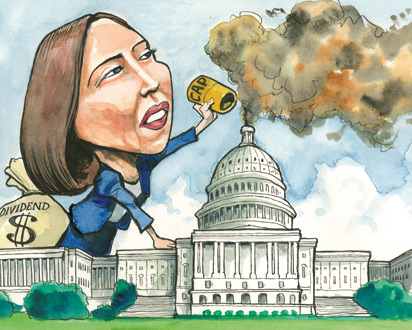Time to swipe the black card
It is a $2 million-demonstration of the power of packaging.

Gold Card: Cap-and-trade is doing damage to the planet—it is time to make a stylish switch, to a direct carbon tax. Images New Zealand Government, Mahurangi Magazine
Fully 11% of the SuperGold Card travel budget has been used on trips to Waiheke Island, apparently helping put the scheme $12 million over budget.
Although any discount and concession scheme would have been welcomed by superannuitants, veterans and widows, an undoubted part of the SuperGold Card’s immense popularity is due to the connotations of its name and its upmarket styling.
It is the perfect way to package for Aotearoa a scheme that, in North America, is an increasingly popular—already favoured by 74%—alternative to emission trading schemes.
In a prayer to President Obama, NASA Goddard Institute for Space Studies director James Hansen gets to the crux of the issue:
An essential corollary to the rising carbon price is 100% redistribution of collected fees to the public—otherwise the public will never allow the fee to be high enough to affect lifestyles and energy choices.
New Zealanders, notoriously early adopters, would waste no time in wielding a ‘100% Carbon’ card, worth perhaps $3000 annually, given to every adult resident. The card, of course, would be styled in silver and black—silver as in inducement, and the ubiquitous black for carbon and nationalism.

Forty-Pager: Senator Maria Cantwell’s cap-and-mostly-payback act is 40 pages. Meanwhile, at more than 1400 pages, the Waxman-Markey cap-and-trade legislation is moribund. Cartoon by KAL, The Economist
Piggybacking on 100% Pure New Zealand works in two important ways:
- The scheme is pure in that 100% of the tax is returned directly, and equally, to taxpayers
- By acting decisively to reduce fossil fuel use, Aotearoa can begin to market the ‘100% Pure’ aspiration with integrity.
To further quote James Hansen:
The rising carbon price will affect almost everything. People’s purchases will reflect a desire to minimize their costs. Food from nearby farms will benefit; imports from halfway around the world will decline. Renewable energies, other carbon-free energies, and energy efficiency will grow; fossil fuels will decline.
Hansen estimates that, what he calls, fee-and-dividend would leave 60% of people better off—those with the smaller carbon footprint.
The 100% Carbon card could function both as a debit card and a loyalty card. Suppliers of certified sustainable goods and services could offer loyalty points that would top up the funds from the shared carbon tax.
The beauty of 100% Carbon also being a low-carbon loyalty card is that it will potentially become more valuable over time, rather than diminish in value as the use of fossil fuels is driven down, and thus its funding base eroded.
A ‘black card’ would be flashed with enthusiasm and pride.
Just like that gold card.
See also David Miliband’s dumped carbon trading card.
